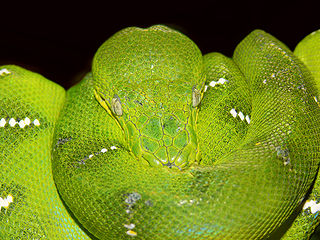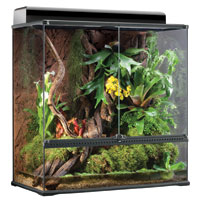Boa Care: Emerald Tree Boa Terrariums, Husbandry and Diet
The breathtakingly-beautiful Emerald Tree Boa (Corallus caninus) has long topped snake enthusiasts’ wish lists. Demanding husbandry requirements and a somewhat surly disposition adds to its mystique. I’ve had some success in breeding this species in zoos, and private keepers have made important strides in recent years, but misconceptions and information gaps persist. Today we’ll discuss Emerald Tree Boa care; please look for my article on its interesting natural history in the near future.
The Terrarium
Cage height is an important factor. Observations of animals kept in small enclosures have led to this snake being labeled as “sedentary”, but those in large, complex habitats move about quite a bit.
An enclosure measuring measuring 4 feet by 3 feet x 4 feet in height is ideal for a large adult. Males and smaller females may get by in 75-100 gallon aquariums turned on their narrow ends, but custom-made cages are a much better option.
Cages that open from the front are preferable, as Emerald Tree Boas are stressed by approaches from above (perhaps because birds of prey are their major predators). In front-opening terrariums, they will often remain on their perches while the cage is serviced (sparing snake and snake-keeper stress and injury!). A variety of commercial cages are suitable for youngsters.
Cage Furniture
Well-anchored branches of varying thicknesses, both forked and straight, should be installed. Emerald Tree Boas often coil at the spot where 2 forks of a branch diverge, so be sure to include several.
Pots of tall, sturdy live plants (philodendron, small ficus trees, snake plants) should be placed about the cage to provide security and aid in humidity control. Artificial plants hung from branches and the cage top can also be used as cover (I favor this model).
Substrate
Newspapers and washable terrarium liners work well as substrates in aquariums. In larger enclosures, cypress mulch or forest floor bedding will allow for easy spot-cleaning and help to raise the humidity level.
Light
UVB exposure is not required, but UVA bulbs may encourage natural behavior, and will bring out the true beauty of their coloration. A day/night schedule of 12:12 hours should be maintained. Red/black reptile “night bulbs” will allow you to observe nocturnal behavior.
Heat
This species is closely associated with rainforests in most keepers’ minds, and this sometimes leads to a misunderstanding of their needs. Arboreal snakes experience greater temperature and humidity fluctuations than do terrestrial snakes living in the same habitats. Emerald Tree Boas prefer cooler temperatures than one might imagine.
Incandescent bulbs should be used to maintain a temperature of 75-77 F, and a basking spot of 85 F. At night, a dip to 72 F is beneficial A ceramic heater or red/black reptile “night bulb” can be used to provide heat after dark.
Large enclosures are necessary if a thermal gradient (areas of different temperatures) is to be established. Thermal gradients, critical to good health, allow snakes to regulate their body temperature by moving from hot to cooler areas.
Humidity
These moist-forest denizens (please see photo of typical habitat) require humidity levels that fluctuate between 60 and 90%. Humidity can be increased via manual spraying, moistening the substrate and commercial reptile misters. Humidity should be highest during the day, and decline with the temperature at night.
Wet conditions and stagnant air will lead to skin diseases. Ample air flow, often overlooked in the past, is now recognized as critical to good health. The terrarium’s top should not be covered with glass to increase humidity; a small fan may be employed to circulate air if necessary.
Emerald Tree Boas are best offered food via tongs. Slowly moving the food in front of the snake, or lightly touching the jaws or body, often induces a strike. Juveniles feed primarily upon lizards and frogs, and many refuse mice. Scenting small mice (fuzzies or hoppers) with a lizard or shed lizard skin may be helpful.
Chicks, quail, gerbils or (for newborns) house geckos may spur picky feeders to take a meal. In time, these can be used to scent mice.
A Note on Meal Size and Frequency
Meal size is an important factor in maintaining good health. Always use smaller food items than you might for similarly-sized snakes of other species. Half-grown rats suffice for even the largest individuals. Regurgitation, a very common ailment, seems linked to overly-large meals and excess food intake.
Emerald Tree Boas have extremely efficient, and somewhat “slow”, digestive systems, and do not usually defecate after each meal. They need comparatively little food, and typically regurgitate if overfed. Snakes confined in small cages that do not allow for sufficient movement often have trouble passing fecal material. Forcing the animal to swim may help.
Newborns should be fed every 10 days; juveniles at 2 week intervals. Adults require, on average, 2 mice or a small rat every 3 weeks.
Water
A bowl should be provided, but most individuals will only take water that is sprayed onto their bodies and the foliage. Some will drink from a watering can tilted in front of the mouth. Punctured plastic containers placed on the cage’s top and small waterfalls may also be utilized.
It can be difficult to provide enough water via misting. Dehydration, indicated by skin ridges and sunken eyes, is not uncommon. At the Bronx Zoo, I’ve injected water into dead rats to accommodate Amethystine Pythons and other reluctant drinkers. Please post below for details.
Handling
Although individuals vary, Emerald Tree Boas rarely accept handling and will bite if forcibly removed from their perches. Their teeth, some of which may reach 2 inches in length, can inflict serious injuries, especially if an eye or nerve is struck. In common with many arboreal snakes, they have quite a long strike range. Emerald Tree Boas are best considered as animals to observe and study rather than handle.
Detachable perches simplify handling, as some individuals will remain immobile if perch and snake are relocated together. Still, a shield and/or a snake hook should be kept between yourself and the animal. Others can be induced to leave their perches and climb onto a hook, but experience is needed. Constructing the cage in a way that allows for cleaning without moving the snake will limit stress and strikes.
 That Reptile Blog – Reptile, Amphibian and Exotic Pet Care and Information
That Reptile Blog – Reptile, Amphibian and Exotic Pet Care and Information



